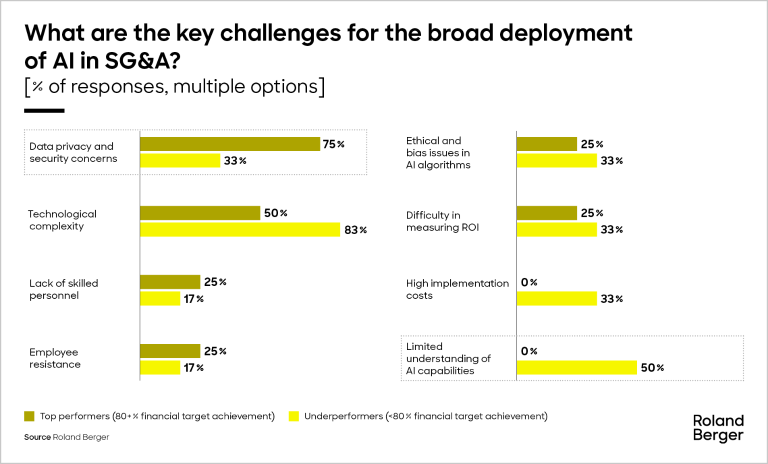Tight margins. Tough decisions. Roland Berger helps you optimize to outperform.


Using AI to supercharge your SG&A functions
What top performers get right – and how you can be one
AI has great potential to drive efficiency, innovation and performance in SG&A functions. Yet just 15% of companies that are using the technology in SG&A have successfully implemented their plans. So what’s going wrong and what are the top performers getting right? Our survey and analysis of the use of AI in SG&A covers AI adoption rates, challenges and success factors, and reveals the practices that differentiate top performers. We consolidate these to provide an AI approach that will transform your SG&A functions and quickly maximize your returns.

Cutting through all today’s hype around artificial intelligence (AI) , it is clear that AI technologies are not currently mature enough to support the vast majority of processes and functions that form an integral part of an organization’s success. Yet there are numerous areas where AI can already have a huge impact. The management of sales, general and administrative (SG&A) expenses is one.
"One of the biggest pitfalls we see is companies overestimating the short-term benefits of AI while underestimating its complexity. A phased rollout – starting with targeted pilots – is the best way to test, learn and refine AI use cases before scaling. It’s a marathon, not a sprint."
SG&A functions play to AI’s strengths. Finance, HR and procurement, for example, often involve repetitive, time-intensive processes that draw on large data sets. Current AI tools, such as robotic process automation (RPA) and natural language processing (NLP; used in chatbots), are designed to streamline such data-based processes, increasing efficiencies and freeing up resources for more value-adding activities.
So why aren’t all businesses using AI tools to improve their SG&A performance? Roland Berger undertook a cross-industry survey to find out. Involving 75 European SG&A decision-makers, it aimed to better understand the current state of AI adoption in SG&A, identify key challenges and success factors, and uncover what differentiates top performers from underperformers. The results also enabled us to develop a customized approach to smooth the implementation of AI in SG&A and maximize results.
What we found
SG&A expenses typically equate to around a quarter of total revenue. Managing them effectively can therefore help to improve profitability, enhance efficiency, support growth and – because they offer valuable data insights – make better, more informed decisions. Our survey found that AI’s potential here has already been recognized – 80% of companies have already begun implementing the technology in SG&A functions. Most aim to use it to unlock additional productivity potential and save costs through efficiency gains , for example, by reducing manual workloads or improving customer service experiences.
IT functions were thought to have the highest potential for efficiency gains, with increases of 33% expected. AI applications in IT include automated helpdesk support (using agents and chatbots, for example), predictive maintenance and enhanced cybersecurity measures. Marketing and sales was another key target area.
However, just ~40% of respondents who have identified initiatives say their company has successfully completed its AI initiatives or are close to completion. Of these, 60% have not achieved their financial and operational targets. Common reasons for not meeting targets include underestimating the complexity of AI integration and overestimating the short-term benefits. Respondents at companies that failed to meet set goals often cited poor alignment between AI initiatives and overall business strategy as the key reason behind suboptimal results. Successful initiatives often involved a phased rollout.
How to become a top performer
We used the survey results to analyze the differences between AI leaders and underperformers. We identified several common challenges and success factors, as well as implications for all organizations wishing to develop the technology.
For example, low performers regard limited AI capabilities and technological complexity as the top challenges, while top performers view regulatory requirements around data privacy and security as the main barrier. When it comes to success, top performers unanimously cite a skilled workforce as the key factor, including prioritizing hiring and developing talent with expertise in AI. They also foster a culture of innovation and leverage partnerships to stay ahead of the curve. Overall, we find that the key to efficient and effective use of AI in SG&A is a precise understanding of its capabilities. For more details on the challenges, success factors and their implications for SG&A functions, including the key factor for efficient and effective use of AI, download the full report.
Our approach
The report also includes details of how we can support your company to maximize its AI results in SG&A. Our approach is based around an AI-focused feasibility and potential analysis, supported by our proprietary AI Use Case Radar. This provides a database of more than >400 use cases to pinpoint valuable AI opportunities across the value chain and help to maximize returns. We draw on these assessments to produce a customized roadmap with clear, actionable steps to effectively implement AI and deliver quick wins.
Register now to access the full study and explore data-driven decisions with AI tools. Furthermore, you get regular news and updates directly in your inbox.












